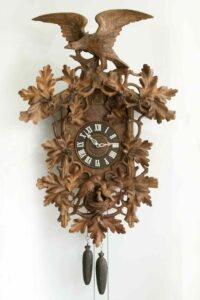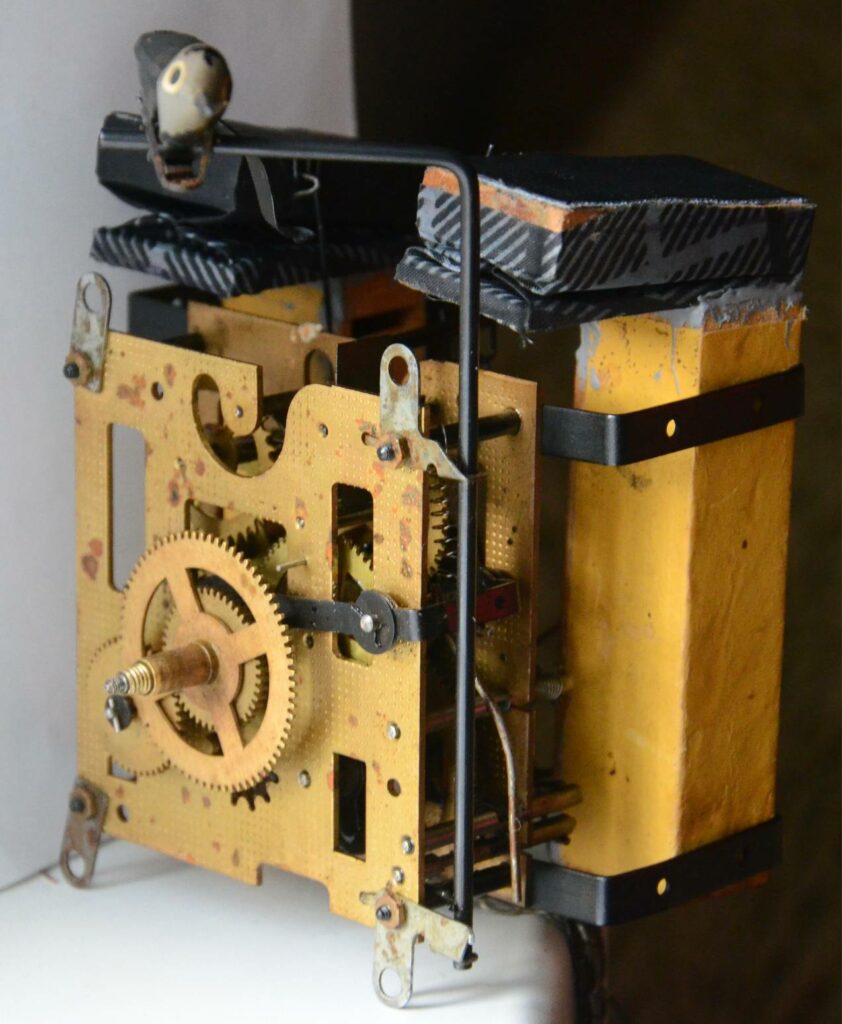
The Black Forest Cuckoo Clock History & Key Facts
The captivating Black Forest Cuckoo Clock – also known as the German Cuckoo Clock – has allured admirers of timepieces, particularly collectors and enthusiasts, for centuries. This traditional, time-honored clock has been in production since the late 1600s or early 1700s, showcasing a combination of Germany’s legendary engineering finesse and craftsmanship. An intriguing saga of innovation, tradition, and artisanship lies behind this iconic clock, making it an exceptionally interesting item indeed!
What is a Black Forest Cuckoo Clock?
A unique and captivating timepiece found in the Black Forest region of Germany, the Black Forest cuckoo clock is an enchanting sight to behold. Featuring handcrafted wooden construction, intricate carvings, vibrant hand-painted accents, and mesmerizing mechanical components that must be wound periodically–including a swinging pendulum and a cuckoo bird which appears at regular intervals–this clock provides ample intrigue for any onlooker. Fascinating and charming, the Black Forest cuckoo clock makes for a truly remarkable item.

Who invented the Cuckoo Clock?
Tracing its roots to Franz Anton Ketterer of Schönwald, Germany, in the late 17th century, the cuckoo clock is an invention with a mysterious origin. Although its exact creator and date of creation remain largely unknown, it’s widely believed to have been produced somewhere between 1670 and 1720; However, one source claims that Phillip Hainhofer described such a clock as early as 1629, owned by Prince Elector August Von Sachsen.

What is a Black Forest Cuckoo Clock made of?
Black Forest cuckoo clocks are traditionally crafted using linden wood, also known as basswood. This distinctive tree (Tilia ssp.) is native to the Black Forest Region in Germany and can be seen across North America and Europe. Other woods, such as pine and walnut, are also used in their making – creating an interesting mix of materials!
What is the purpose of a Cuckoo Clock?
The purpose of the Black Forest Cuckoo Clock is to provide a decorative timepiece that chimes the time with a cuckoo call every hour.
Which bird is typically featured in the traditional Cuckoo Clock?
The Common Cuckoo is the bird on which the Cuckoo Clock is based, with its signature ‘coo-coo’ sound. In addition in the Black Forest, it was considered to be good luck to hear the Cuckoo bird singing in the forest.

How does The Mechanical Movement work in Cuckoo Clocks?
The pendulum swings back and forth at an even beat—one second for every back-and-forth movement—when weights at the bottom of the pendulum drive the movement through gravitational pull. (On a cuckoo clock, the pendulum is often shaped like a maple leaf, and the weights are shaped like a pinecone.) The weights are attached to a chain wrapped around a chain gear that drives the internal gears of the cuckoo clock. The descent of the weights causes the gears to turn, producing the “tick-tock” sounds and cuckoo calls associated with these weight-driven clocks.

Non-musical cuckoo clocks have two weights, whereas musical cuckoo clocks have three. The first weight in both clocks serves as the clock’s timekeeping function, while the second controls the cuckoo sound and the bird’s movements. A third weight drives the music box in musical cuckoo clocks. The weights are suspended on chains beneath the cuckoo clock and gradually fall. When the weights reach the floor, the pack is simply retracted to restart the clock.
Whether a cuckoo clock operates on a daily or weekly cycle determines how quickly the weights drop. An eight-day movement cuckoo clock is more expensive because it is larger and more complex, but it only needs to be wound once a week. One-day movement cuckoo clocks only run for one day, require winding once per day, and have lighter weights – making them the less costly option.
If the clock’s sound is turned off manually, the owner must remember to turn it back on each morning. Cuckoo and music can be silenced automatically from 9 p.m. to 8 a.m. on some models of eight-day movement clocks. In most cases, automatic shutoffs will cost you a little more than their manual counterparts.
Two songs are typically featured on clocks with musical mechanical movements. The Happy Wanderer and Edelweiss are the most frequently heard. The music on an eight-day cycle cuckoo clock changes every hour, while on a one-day cycle clock, it changes every half hour.
A cuckoo clock with a mechanical movement is a testament to the skill and dedication of Germany’s old clockmakers. Nothing much has changed in the last few centuries. The mechanical cuckoo clock’s moving parts and musical mechanism are powered by weights that rely solely on gravity.
The Cuckoo Mechanism
Every hour on the hour, a little cuckoo bird is released from the clock and makes its distinctive call. Clocks on a mechanical movement have two tiny air chambers, or bellows, made of wood, one on each side. The clock’s motion activates the bellows, squeezing air into and out of the whistles, filling the chambers with sound. The first bellow produces the ” cu ” sound, while the “ckoo” sound is made by the second. Cuckoo calls vary in volume depending on the clock’s bellows and pipes.
The cuckoo bird is a standard feature of cuckoo clocks. The clock’s mechanism also propels the entrance and exit of the cuckoo bird. Cuckoo sounds and motion are created electronically in quartz movement battery-powered clocks.
Other Styles of Cuckoo Clocks
- Chalet style cuckoo clock: Features a wooden chalet house design and are the most popular and recognizable type of cuckoo clock.
- Chalet-style with music box: This type of cuckoo clock features a music box in addition to the cuckoo call.
- Carved cuckoo clocks: These clocks feature intricate carvings on the wood and represent a more traditional style of cuckoo clock.
- Modern cuckoo clocks: This style normally features more modern designs and often incorporates digital elements into it.
- Pendulum cuckoo clocks: These feature a swinging pendulum and typically feature a more traditional design.
History of The Cuckoo Clock
The Date of the First Black Forest Clock
Unfortunately, the date when the first Black Forest clock, the progenitor of all cuckoo clocks, was made is now unknown. It is commonly stated that clocks made in the Black Forest were first produced between 1670 and 1720. Some sources place this date as far back as 1640 or even 1629. There’s no doubt that the clockmaking business exploded in the 18th century. Furtwangen was the timepiece industry’s epicentre back then. I didn’t know that.

The Rise of the Clockmaking Industry
For practical and legal reasons relating to the guilds, wood was initially the material of choice for making cases and mechanisms. Aside from its rich history working with wood, the Black Forest also had a natural intuition for the kinds of products that could provide rural residents with a reliable source of supplemental income. Artistic Black Forest clocks didn’t start particularly fancy or elaborate. The foliot clock, a forerunner to modern clocks, was a crude wooden gear clock with an exposed mechanism and a wooden pendulum that kept time by swinging back and forth. The stone-weighted clock only displayed the time of day. These early clocks from the Black Forest used a 12-hour mechanism. As time went on, metal and brass gradually supplanted the wooden mechanisms.
The Spread of Black Forest Clocks
Soon, the Black Forest’s enterprising citizens sold their clocks along the international trade routes used by the region’s glass industry. According to legend, the first clocks arrived in the Black Forest from Bohemia carried on the backs of people working as “glass carriers” in a wooden framework, kicking off Black Forest clock production.
This period marked the beginning of the clockmaking industry in the Black Forest. Soon after, clock carriers appeared; their high carrier frames are a recognisable design element on many contemporary cuckoo clocks. Sellers of Black Forest clocks quickly established themselves across Europe along these trade routes, consolidating inventory and achieving widespread success through on-the-spot sales.
The Boom of the 18th and 19th Centuries
Clocks made of Black Forest linden wood were increasingly both affordable and dependable. As more people could purchase them, wall clocks of all varieties quickly became an essential household item, and demand skyrocketed.
Handmade clockmaking took a lot less time in the 18th and 19th centuries. Spindle drills, gear profiling machines, and the rise of specialists in related but distinct fields all played critical roles. Production processes were streamlined and improved as case makers, shield painters, and chain makers collaborated on projects. Production rates of clocks per worker per week have increased six-fold in the past century. In the early days, roughly half of all Black Forest clocks made were lacquered shield clocks (shield clocks) rather than cuckoo clocks.
The Decline of Black Forest Clocks
The years between 1800 and 1840 were ones of unprecedented expansion. Production and sales reached as high as 600,000 clocks annually. Wholesale businesses were called upon to find answers to the growing number of distribution and logistics issues. The independent clockmakers were incapable of, and unwilling to pursue, these responsibilities. They were completely swamped with the ever-growing and more difficult task of manufacturing the requested clocks. Following a period of crisis and significant economic upheaval, production reached 1.8 million clocks in 1870 and 5.8 million clocks by 1905. In 1905, the Black Forest was responsible for half of the world’s exported clocks. If large clock factories were to replace the smaller craft shops, the desired output increase would be realised.
Sales of Black Forest clocks plummeted after World War I and II and have never recovered to their pre-war heyday. Since the 1970s, with the introduction of plastic and quartz mechanisms, modern cuckoo clock design has radically altered to use these new mechanisms.
The Renaissance in Modern Times
Trends have, however, shifted recently. Traditional craftsmanship is experiencing a renaissance, and with it comes a surge in interest in handmade clocks worldwide. In particular, the cuckoo clock, THE Black Forest clock par excellence, is enjoying a global renaissance. I don’t even know what that means.




